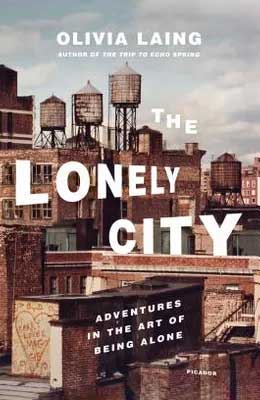Adventures in the Art of Being Alone, is a profound testimony on artists and solitude.

Olivia Laing considers her life and the lives of six great artists in this collection of reflections on being alone. Her examination of Andy Warhol, quite a loner and yet surrounded by people, provided me with a much deeper knowledge of Warhol’s childhood and his ultimate demise. Several artists that I had never heard are revealed including Henry Darger, Klaus Nomi, David Wojnarowicz, and Josh Harris, providing a springboard for the author to reflect on her own solitary New York City existence.
A Bundle of additional assets…
The Lonely City directly led me to Alone Together : Why We Expect More from Technology and Less from Each Other, by Sherry Turkle and Totally Wired: The Rise and Fall of Josh Harris and the Great Dotcom Swindle, a book by Andrew Smith about the unpeopled and friendless life of perhaps “the most famous Internet entrepreneur you probably never heard of.” She also pointed me to two documentary films on the work of Josh Harris: We Live in Public (full length feature below) and Harvesting Me, that cover two of his most radical social experiments.
“My only friend was the tube.”
In Living in Public, a 1999 entering-the-millennium bunker test of individual sanity. Harris intends to strip away any trace of privacy, a 30-day world in which everyone becomes both the subject and the object of scrutiny. All was recorded on 110 video cameras, projected live on hundreds of TV monitors, with all recordings owned by Harris.
In Quiet, where Harris announced “People will literally be purchasing slices of my life,.” he outfitted his apartment with 32 camera streaming his continuous daily life live on a website. Wanting to be watched and then getting what he wanted not including a stock market collapse, a lost relationship, and most of his $50 million fortune lost while broadcasting it all live, 24/7, a fish in a bowl, living in public, the personal edition.
While I was fascinated with Josh Harris, I became deeply immersed in Laing’s coverage of David Wojnarowicz.
Beginning in the late 1970s, David Wojnarowicz (1954–1992) created a body of work that spanned photography, painting, music, film, sculpture, writing, and activism.
On a trip to Mexico City with Tommy Turner to scout Day of the Dead imagery, David Wojnarowicz shot 25 rolls of super-8 film, documenting scenes that embodied the violence of city life. A central image is that of a child exploited as a fire-breathing street performer, which resonates in the title of the film and Wojnarowicz’s own experience hustling on the streets at a young age. He later staged scenes in his New York City apartment to combine with this footage, collecting dreamlike images to illustrate thematic sections he planned for the film’s structure, outlined in a cutting script. Among these images is a dancing, gun-wielding marionette, coins dropping into a plate of blood, vibrantly colored loteria cards, and the now iconic self-portrait of the artist with his lips sewn shut.
A Fire in My Belly was never completed. What currently circulates and is preserved in the Fales Library Collection of NYU, which holds the David Wojnarowicz Papers archive, is a 13-minute version entitled A Fire in my Belly, A Work in Progress, and a 7-minute excerpt that possibly represents a chapter planned for the finished version.
Here are the two complete segments of the film, a work in progress…
The New York Times declared that “his most lasting legacy will be as a writer.” Our bookshop features a selection of his books…
In his full but regrettably brief lifetime, David Wojnarowicz was many things: a visual and performance artist whose radical work incensed the right-wing establishment, a tireless AIDS and anticensorship activist, and, most emphatically, a writer. I just started reading The Waterfront Journals (1997). Grove/Atlantic, a collection of his early works of autobiographical fiction. Written as short monologues, each is in the voice of one of the many people he encountered in his travels throughout America in the late 1970s and early 1980s, when he was living on the street. Wojnarowicz stumbles upon his characters in bus stations, at the side of the road, in hotels, coffee shops, and back alleys, where their interactions are less than epic, but unnervingly intimate.
A new film, “Wojnarowicz: Fck You Fggot F**ker” profiles one of the most controversial and polarizing artists to come out of the New York art world of the eighties.
Directed by Chris McKim. Produced by McKim, WOW Doc & World of Wonder’s award-winning team Randy Barbato & Fenton Bailey (RuPaul’s Drag Race). It opened March 19 nationwide through Kino Marquee virtual cinemas.
Exclusive access to his breathtaking body of work – including paintings, journals, and films – reveals how Wojnarowicz emptied his life into his art and activism. Rediscovered answering machine tape recordings and intimate recollections from Fran Lebowitz, Gracie Mansion, Peter Hujar, and other friends and family help present a stirring portrait of this fiercely political, unapologetically queer artist.
